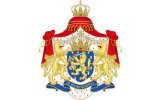The Martinitower
In Groningen-language "Ôle Grieze" (= Old Gray One)
First of all you must know that the capital of the province Groningen also is named Groningen. To avoid misunderstandings in the text below the province is, where need, indicated as Groningen(p) and the capital as Groningen(c).
As the first and the most welknown symbols for the province and the town Groningen, and even in Holland, is with his (or here?) 96,8 meter of height the "Martinitoren" (= Martini-tower). With this height the tower is the 6th in height of the Netherlands.
The tower, and the belonging church, are called after Saint Martinus or  "Sint Maarten". The holy Martinus of Tours (316-397) was in that time the patron of the diocese Utrecht of which Groningen(p) was part for a long period.
"Sint Maarten". The holy Martinus of Tours (316-397) was in that time the patron of the diocese Utrecht of which Groningen(p) was part for a long period.
The first tower was build in the 13th century, so somewhere between the years 1200 and 1300. Because of lightning in the years after the tower was destroyed two times. The third tower, which is still existing, was mainly build in the years 1469 - 1482. The wooden superstructure and spire were completed in 1548. The tower should have beene more then 100 meters in height and according to impossible stories even more than 127 meters.
In the years before 1577 Groningen(c) was besieged by Spanish and Walloon troops. When these troops withdraw in 1577 bonfires were kindled on the third pinnacle. The wooden superstructure and spire were set on fire and the tower partly came down. Only 69 meters were saved. (The comparison with the fifth wonder of the world, the light-house of Pharos in Alexandria (ca 1259 B.C.) is pressed forward, is'n it?) (Shame, but with pleasure I would have seen the tower burning! J.B.) The reconstruction of the tower was finished in 1627. During the second worldwar the Martinitower had very little damage.
Like every selfrespecting tower the Martinitower has the needful church bells and a carillon.
Church bells.
In the years 1577 and 1588 three big bells were installed in the Martinitower, respectively the "Salvator" (7850 kg) the big "Borgerklok" (4200 kg) and the small "Borgerklok" (3400 kg). For centuries these bells have announced joy and sorrow , war and peace over the Groningen country. In 1826 this tradition was unfortunately abolished. On the occasion of the 950th anniversery of Groningen(c) a new bell was installed in 1994. This bell is named after a silver coin named "Kromstaart". The "Kromstaart" was in use for several centuries . On this bell, with a weight of 5550 kg, is inscripted the following poem.
was unfortunately abolished. On the occasion of the 950th anniversery of Groningen(c) a new bell was installed in 1994. This bell is named after a silver coin named "Kromstaart". The "Kromstaart" was in use for several centuries . On this bell, with a weight of 5550 kg, is inscripted the following poem.
You may call me Kromstaart. The Groningen-people I will praise, because the people of city and country donated me generous. 1440-1990 Groningen city 950 year.
Since then a number of bells from other buildings and of a bell-factory were installed so there are now 12 churchbells in the Martinitower. Only the cathedral in Utrecht has more churchbells. If all these bells with a combined weight of more than 25.000 kg (yes, more than 25 tons) are ringing all together you may expect that the tower is wobbling a little bit. Of course no centimeters, but yet....
Below there is a little film on which you can hear how the bells sound alltogether when they are ringing. Persist a few minutes because the big bells start somewhat later. (And if you are interested: between minutes 9.35 and 10.10 you can see how Dutch people put up there bicycle!)
The carillon.
The carillon of the Martinitower is largely moulded in 1662/1663 by the family Hemony and originally had a range of 3 octaves (32 bells). In 1984 five smaller and 2 larger bells were added and up to now these bells sounds the hour and the half-hour. Nowadays the carrilon includes 4 octaves, that is 49 bells. Besides that the carillon has the disposal over 3 churchbells. So all in all there are 52 bells available for the carillon and that is the second biggest in the Netherlands. If you want to listen to the cariilon then click on the film below.
The Martinichurch.
Of the Martinichurch, appertaining to the Martinitower, (in fact it is the other way around because the city Groningen is owner of the tower) is known that about the year 1000 there was already a church near the Martinikerkhof. Remnants have been found during the last restoration of the foundations of the present Church. If you want more information about the Martinichurch you can find it in www.martinikerk.nl
Sunt-Meerten-lopen of lichieslopen.
(The title cannot be translated in proper English. Litteraly it means: Saint-Martinus-walking or light-walking)
 On 11 November, the name day of Sint Maarten, it is a tradition in Groningen(p) that children with a chinese lantern (1) in which a burning candle stroll around in the neighbourhood to visit neighbors, relatives and acquaintances. After singing a song about Sunt Meerten the children expect to get some candy, a few cents, some fruit, some nuts, or something like that. (2)
On 11 November, the name day of Sint Maarten, it is a tradition in Groningen(p) that children with a chinese lantern (1) in which a burning candle stroll around in the neighbourhood to visit neighbors, relatives and acquaintances. After singing a song about Sunt Meerten the children expect to get some candy, a few cents, some fruit, some nuts, or something like that. (2)
Some songs are as follows:
Sunt Sunt Meerten Saint Saint Maarten
koien droagen steerten, cows do have tails
hier woont een riek man here lives a rich man
dei wel wat missen kan who can give a few things
geef mie 'n appel of 'n peer give me an appel or a pear
kom ik 't haile joar nait weer. you don't see me back the whole year.
Another song is:
Sunt Metinus bisschop Saint Martinus bishop
roem van aale laanden fame of all countries.
dat ik hier met lichies loop that I walk with little lights
is veur ons gain schaande is no shame for us
Hier woont ain riek man Here lives a rich man
dei ons wel wat geven kan who can give a few things
ain cent, 'n appel of ain peer a cent, an appel or a pear
kom ik 't huile joar nait weer. you don't see me back the whole year
't Haile joar dat duurt zolank The whole year is as long
tot mien lichie branden kan as my candle burns.
Another variant is:
Sunter Meerten tuutje Saint(er) Maarten "tuutje"
mien voader dei hait Luutje my father's name is Luutje
mien mouder dei hait Jantje my mother's name is Jantje
geef mie 'n cent in 't handje give me a cent in my little hand
geef mie ain appel of ain peer give me an appel or a pear
den kom ik 't haile joar nait weer. you don't see me back the whole year.
And if you got nothing the children sang:
Hier woont juffrouw Kikkerbil here lives miss "frog-leggs"
dei ons niks meer geven wil. who don't want to give anything.
(1) Sometimes the children use a hollowed sucar-beet. The beet then is decorated with engravings on the outside. The children carry about the beet with a metal wire. The comparison with Halloween in America then is obvious isn't it!
(2) You can compare this with the following. Usually on 6 Januari children In the south of the Netherlands go along the doors in the neighborhood because of the feast of the three bible kings Casper, Melchior and Balthasar. The children expect that they, after singing a song, are rewarded with some candy, a few cents, some fruit etc. Most times the children are beautifull dressed up like the three kings. And don't be surprised if there are 2, 4 or even 5 kings appearing at your door! A little song is as follows:
Drie koningen, drie koningen, geef mij een nieuwe hoed, Three kings, three kings, give me a new hat
De ouwe is versleten, mijn moeder mag 't niet weten: The old one is worn out, my mother must not know
mijn vader heeft het geld op de toonbank neergeteld. My father layd the money on the counter.
 Wapen van Groningen
Wapen van Groningen Canadian coat of arms
Canadian coat of arms Wapen van Nederland
Wapen van Nederland South-African coat of arms
South-African coat of arms